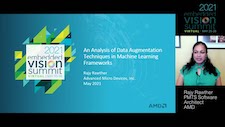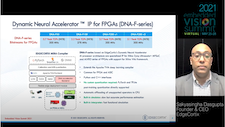| LETTER FROM THE EDITOR |
Dear Colleague,
Until this Friday, January 28, the Edge AI and Vision Alliance is accepting applications for the 2022 Edge AI and Vision Product of the Year Awards competition. The Edge AI and Vision Product of the Year Awards celebrate the innovation of the industry’s leading companies that are developing and enabling the next generation of edge AI and computer vision products. Winning a Product of the Year award recognizes your leadership in edge AI and computer vision as evaluated by independent industry experts. Winners will be publicly announced at the Embedded Vision Summit, the key event for system and application developers who are incorporating computer vision and visual AI into products. For more information on the Edge AI and Vision Product of the Year Awards and to enter, please see the program page. Again, the deadline for applications is January 28. Registration for the Embedded Vision Summit, taking place May 17-19 in Santa Clara, California, is also now open, and if you register by March 11, you can save 25% by using the code SUMMIT22-NL. On Thursday February 24 at 9 am PT, BrainChip will deliver the free webinar “Developing Optimized Systems with BrainChip’s Akida Neuromorphic Processor” in partnership with the Edge AI and Vision Alliance. BrainChip’s Akida processor today finds use in a diversity of applications, such as classifying images, identifying odors and tastes, recognizing breath data for disease classification, identifying air quality, interpreting LiDAR laser light data, recognizing keywords, and detecting cybersecurity attacks. Akida leverages advanced neuromorphic computing as its processing “engine”, delivering key features such as one-shot learning and on-device computing with no “cloud” dependencies. As such, it’s particularly valuable in evolving smart “edge” devices, where privacy, security, low power consumption, low latency and high performance, low cost, and small size are all important criteria. In this session, you’ll learn how to easily develop efficient AI in edge devices by implementing Akida IP either into your SoC or as standalone silicon. The presenters will provide detailed performance and other results, derived from real-life system implementations using production Akida silicon, as well as share a variety of design techniques and support resources. For more information and to register, please see the event page. Brian Dipert |
| ASSESSING AND ENHANCING DEEP LEARNING MODELS |
|
Facing Up to Bias An Introduction to Data Augmentation Techniques in ML Frameworks |
| EMBEDDED AI SOFTWARE DEVELOPMENT TOOLS AND TECHNIQUES |
|
Quickly Measure and Optimize Inference Performance Using Intel DevCloud for the Edge Dynamic Neural Accelerator and MERA Compiler for Low-latency and Energy-efficient Inference at the Edge |
| UPCOMING INDUSTRY EVENTS |
|
Developing Optimized Systems with BrainChip’s Akida Neuromorphic Processor – BrainChip Webinar: February 24, 2022, 9:00 am PT Embedded Vision Summit: May 17-19, 2022, Santa Clara, California |
| FEATURED NEWS |
|
BrainChip Achieves Full Commercialization of Its AKD1000 AIoT Chip with Availability of Mini PCIe Boards in High Volume Train Smart Retail AIs 50x Faster with Mindtech’s New Synthetic Data Application Pack e-con Systems Launches 13 Mpixel Monochrome USB 3.1 Gen 1 Camera with High Sensitivity Intel Empowers Developers with oneAPI 2022 Toolkits Syntiant Announces Voice-Enabled Ultra-Low-Power Reference Design for True Wireless Stereo Earbud Applications |






